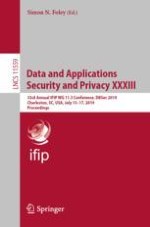This book constitutes the refereed proceedings of the 33rd Annual IFIP WG 11.3 Conference on Data and Applications Security and Privacy, DBSec 2019, held in Charleston, SC, USA, in July 2018.
The 21 full papers presented were carefully reviewed and selected from 52 submissions. The papers present high-quality original research from academia, industry, and government on theoretical and practical aspects of information security. They are organized in topical sections on attacks, mobile and Web security, privacy, security protocol practices, distributed systems, source code security, and malware.
